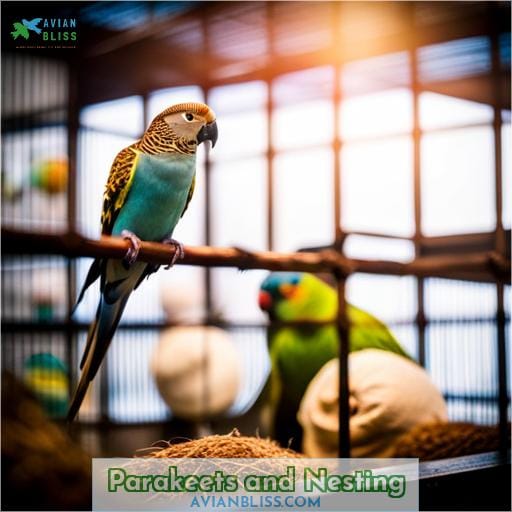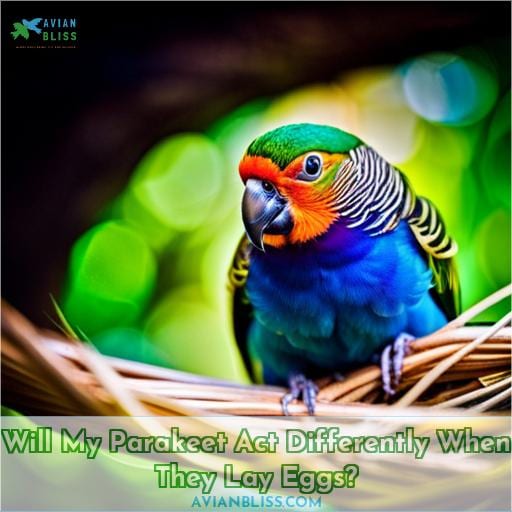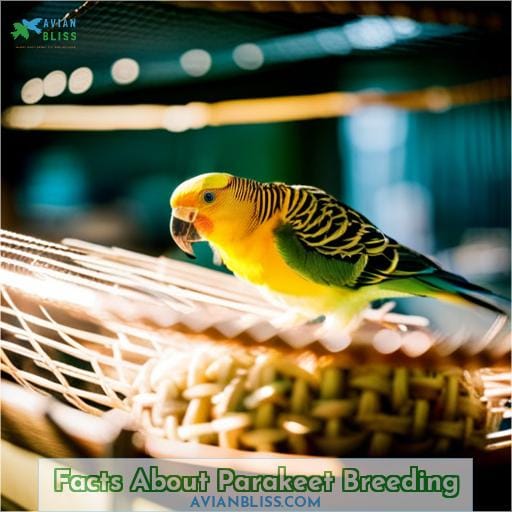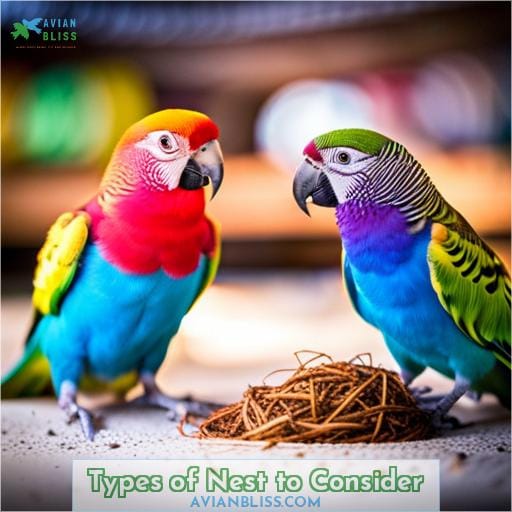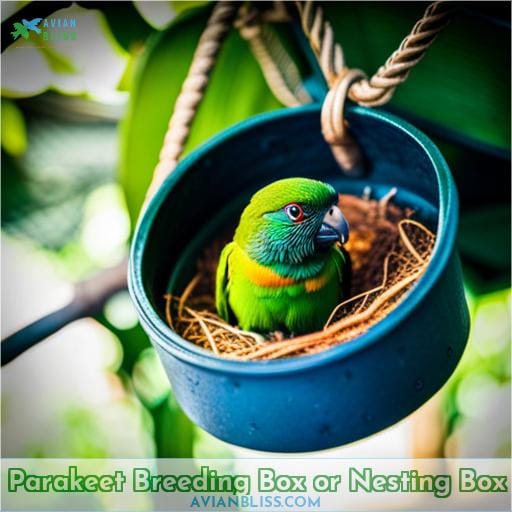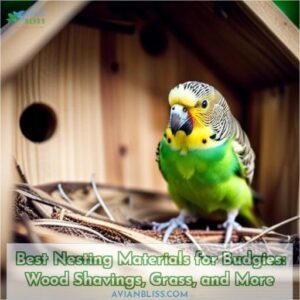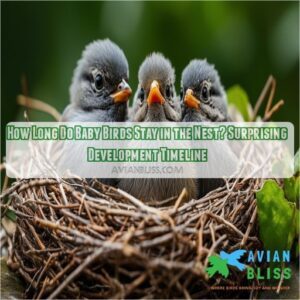This site is supported by our readers. We may earn a commission, at no cost to you, if you purchase through links.
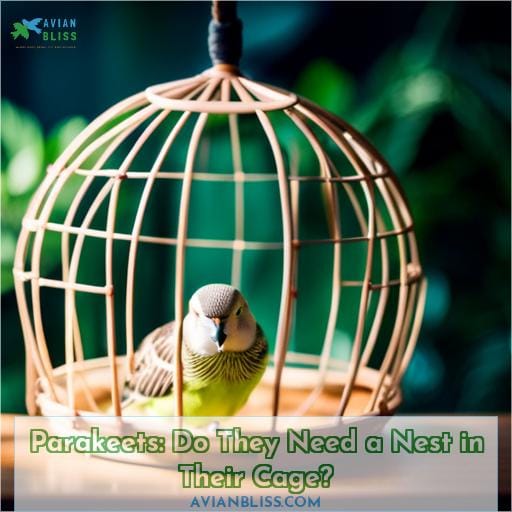 Discover the fascinating world of parakeets and their nesting habits.
Discover the fascinating world of parakeets and their nesting habits.
Have you ever wondered if these colorful birds need a nest in their cage? Well, the answer might surprise you! Parakeets do indeed require a cozy nest for various reasons, including breeding and sleeping.
In this article, we will delve into why nests are essential for parakeet well-being and explore different types of nests to consider for your feathered friend’s comfort.
Table Of Contents
- Key Takeaways
- Do Parakeets Need a Nest in Their Cage
- Parakeets and Nesting
- Can Parakeets Breed in Captivity?
- What Do Parakeets Need for Nesting?
- Will My Parakeet Act Differently When They Lay Eggs?
- Facts About Parakeet Breeding
- Types of Nest to Consider
- Parakeet Breeding Box or Nesting Box
- Frequently Asked Questions (FAQs)
- What are the benefits of providing a nest for parakeets in their cage?
- Can parakeets breed without a nest in their cage?
- Are there any alternatives to traditional nest boxes for parakeets?
- How can I encourage my parakeet to use a nest in their cage?
- What should I do if my parakeet shows aggression or changes in behavior when they lay eggs?
- Conclusion
Key Takeaways
- Parakeets have natural nesting instincts, and providing a nest in their cage can fulfill their need for a secure and comfortable space.
- Different types of nests, such as breeding boxes or soft rope nests, can be used to cater to different breeding behaviors and preferences of parakeets.
- Nesting materials, such as sterilized coconut fiber or shredded paper, can be provided to encourage nesting behaviors and create a suitable environment for egg-laying.
- Observing and supporting parakeets during their breeding phase, including understanding their behavioral changes and hormonal shifts, is crucial for their well-being and successful breeding.
Do Parakeets Need a Nest in Their Cage
As an avian veterinarian, it’s important to consider the needs of parakeets when it comes to their cage setup.
While wild parakeets don’t build nests on their own, providing a nest in their cage can offer them privacy and a sense of security.
Options such as sterilized coconut fiber nesting material or specially designed nesting boxes made from natural wood can provide your parakeet with a safe and comfortable space for resting, breeding, and hatching eggs.
Sterilized Coconut Fiber Bird Nesting Material
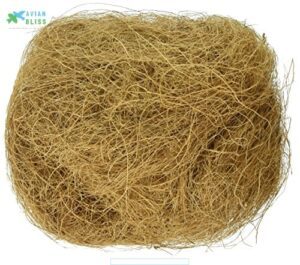
Yes, parakeets need a nest in their cage to provide them with a safe and comfortable space for resting, nesting, and breeding.
Sterilized Coconut Fiber Bird Nesting Material is an excellent choice for creating the perfect nesting environment for your pet bird. The sterilized coconut fibers offer a natural and cozy material that allows them to build sturdy nests as per their instincts.
This type of nesting material ensures the safety and well-being of your parakeet while providing insulation against temperature changes.
- Provides a safe and comfortable space for resting, nesting, and breeding.
- Made from sterilized coconut fibers to ensure cleanliness.
- Natural materials mimic the birds‘ wild habitat.
- Some birds may not prefer this particular type of nesting material.
- Availability may vary depending on location or supplier.
Overall Opinion: Sterilized Coconut Fiber Bird Nesting Material is highly recommended as it offers comfort, safety, insulation,and mimics natural habitats.
Sukh Bird Nesting Material Mix
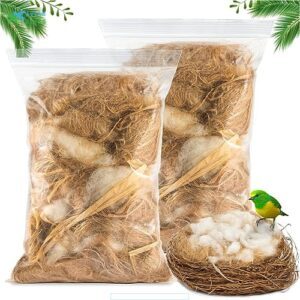
You’ll be glad to know that parakeets absolutely benefit from having a nest in their cage, and the Sukh Bird Nesting Material Mix is an excellent option to provide them with a cozy and comfortable space.
This high-quality nesting material mix is made of natural fibers like jute silk, hemp rope, cotton, agave sisalana, and raffia. It offers dryness, softness, flexibility for easy shaping into nests of various sizes.
With its dust-free composition and minimal particles for easy cleaning around the cage area , it’s perfect for small birds such as budgies or canaries.
- Made of 100% natural fibers
- Provides a soft and cozy environment for parakeets
- Dust-free with minimal mess
- May require regular replacement if soiled or damaged
Parakeet Nesting Box Bird House

You’ll find that a Parakeet Nesting Box Bird House is an essential addition to your parakeet’s cage for providing them with a secure and comfortable space to rest, build nests, and breed. This nesting box is designed specifically for the needs of parakeets, ensuring they’ve a safe environment for these important activities.
- Provides privacy: The enclosed design of the nesting box gives your parakeets the privacy they need during resting and breeding.
- Mimics natural habitat: By offering a designated space for nest building, this bird house allows your parakeets to exhibit their natural instincts in captivity.
- Promotes breeding behavior: With its perch entry/exit point and appropriate size options, this bird house encourages breeding behaviors in your birds.
- Requires regular cleaning: As with any enclosure or accessory in your pet’s cage, it’s necessary to clean the nesting box regularly to maintain hygiene standards.
- Limited space inside cage: Adding another item like the Parkeet Nesting Box may reduce available space within the cage; consider adjusting other elements accordingly.
Overall though,the use of a Parkeet Nesting Box Bird House is a great way to provide your parakeets with a safe and comfortable space to rest, build nests, and breed.
Parakeet Nesting Box Natural Wood
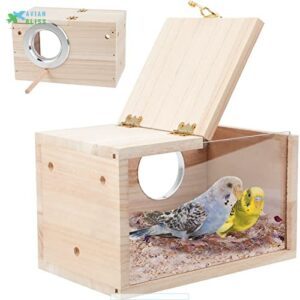
You’ll find that providing a parakeet nesting box made of natural wood is essential for creating a comfortable and secure environment in their cage.
This beautifully designed wooden nesting box encourages natural behaviors and fosters breeding behavior, providing a sense of security for your parakeets.
The innovative transparent side allows easy observation without disturbing the birds, while the high-quality material ensures it’s safe and healthy for them.
Easy to install and clean, this nesting box offers an ideal habitat for hatching baby birds.
- Encourages natural behavior
- Innovative design with transparent side
- High-quality material
- May take up space in the cage
- Requires regular cleaning
- Some parakeets may not use it initially
Parrot Nesting Box
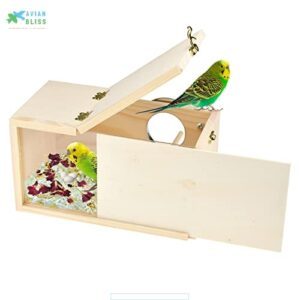
You’ll find that a parrot nesting box is an essential addition to your parakeet’s cage. This specially designed wooden box provides a safe and secure space for your parakeets to breed, rest, and relax.
The transparent acrylic side allows you to observe their behavior without disturbing them while the wooden interior offers a dark environment for privacy at night. Installing this nesting box inside or outside the cage is easy, and it comes with a hinged lid for effortless cleaning and changing of bedding materials.
- Provides a safe and cozy habitat for breeding.
- Transparent acrylic side allows clear observation of parakeets.
- Easy installation inside or outside the cage.
- Requires regular cleaning to maintain hygiene.
- May take up additional space in the birdcage.
- Some birds may not immediately adapt to using it as their nest.
Parakeets and Nesting
When it comes to parakeets and their nesting habits, you’ll quickly discover that these social birds have a natural inclination to create cozy nests for themselves. Understanding their nesting preferences is essential for providing them with the right environment.
- Nesting Materials: Parakeets prefer soft materials like pine shavings or shredded paper in their nests.
- Sleep Habits: Proper sleep is crucial for parakeet well-being. Providing a dark, enclosed space like a pre-built sleeping hut or bed helps ensure undisturbed rest.
- Behavioral Changes: During breeding rituals and egg-laying, parakeets may exhibit hormonal changes leading to increased aggression. It’s important not to handle them during this time.
By catering to your parakeet’s nesting needs and understanding their behavior patterns, you can provide an enriching environment that promotes happiness and overall well-being.
Parrot Nesting Box
Can Parakeets Breed in Captivity?
To breed parakeets in captivity, you need to ensure that they have the right conditions and resources. Understanding their breeding behaviors and providing suitable nesting preferences is essential for successful breeding.
Parakeets exhibit strong parenting instincts and require privacy during this time.
| Breeding Behavior | Nesting Preferences | Parenting Instincts |
|---|---|---|
| Parakeets mate for life, going through a courting phase before breeding. | Having a private space where they can lay eggs without disturbances is important. | Parakeet parents become protective of their eggs, displaying enhanced aggression towards potential threats or intruders. |
Environmental Impact
Breeding in captivity allows us to control environmental factors such as temperature, lighting, diet which impact successful reproduction.
By understanding parakeet behavior and meeting their specific needs during the reproductive period, we can support healthy breeding habits that contribute to both individual bird welfare and species conservation efforts.
What Do Parakeets Need for Nesting?
Now, let’s talk about what your parakeets need for nesting.
Nesting materials play a crucial role in satisfying their nesting instincts and providing them with a safe and comfortable environment.
Parakeets prefer soft bedding materials like pine chips or shredded paper to line their nests. These materials not only provide insulation but also create a cozy space for incubating eggs and raising chicks.
When it comes to the actual nest, parakeet owners can consider using specially designed parakeet nesting boxes that have an opening large enough for easy access but small enough to prevent escape of the birds or eggs.
Monitoring the nest is essential during this time, ensuring proper hygiene by regularly changing the bedding material as needed while respecting their privacy during egg-laying periods.
Will My Parakeet Act Differently When They Lay Eggs?
As your parakeet prepares to lay eggs, you may notice some changes in her behavior and demeanor. It’s important to understand that these behavioral changes are a result of hormonal shifts and maternal instincts kicking in.
Here are three ways your parakeet may act differently during the egg laying process:
- Increased Nesting Behavior:
- Your parakeet will exhibit nesting behaviors such as shredding bedding material or rearranging cage accessories to create a suitable nest for her eggs.
- During this time, your normally friendly parakeet may become more territorial and aggressive towards other birds or even humans who approach the nesting area.
- Female parakeets typically lay one egg every two days until their clutch is complete, which can range from 4-8 eggs on average.
Understanding these behavioral changes can help you provide the necessary support for your parakeet during this natural process of breeding and parenting.
Facts About Parakeet Breeding
Understanding the facts about parakeet breeding can help you provide the best care for your feathered friend.
Parakeets have intricate courtship rituals that involve beak tapping and wing lifting to establish pair bonds. Once bonded, they may exhibit nesting behaviors such as excessive bedding shredding and laying unfertilized eggs.
Hormonal changes trigger these actions, leading to heightened aggression in some birds. During the breeding season, it’s important not to handle them excessively or disturb their nesting preferences.
Parakeets prefer closed nest boxes made of wood for privacy during egg-laying behaviors. These boxes should be lined with soft materials like pine chips for comfort and insulation purposes. Female parakeets typically lay eggs on separate days, which take less than 18 days to hatch if fertilized.
By understanding these mating signs and preferences in parakeet behavior, you can create a suitable environment that supports their natural breeding instincts while ensuring their well-being throughout the process.
Types of Nest to Consider
When considering the types of nest to provide for your parakeet, it’s important to consider their specific needs and behaviors.
Sleeping and play nests offer a secure and comfortable space for rest, while breeding nests are essential if you plan on allowing your parakeets to breed.
These nesting options should be carefully chosen based on their materials, design, and ease of cleaning in order to promote the well-being of your feathered friends.
Sleeping and Play Nests
When considering the nesting needs of parakeets, it’s important to explore different types of nests that cater to their sleeping and play preferences.
Parakeets have unique sleeping patterns and nesting preferences, so providing them with suitable beds and toys in their cages is essential.
Understanding parakeet sleeping habits will help you create a comfortable space for them while promoting healthy social behavior within the cage.
Breeding Nests
You need to provide a suitable breeding nest for your parakeets in their cage. Consider the following types of nests to cater to their nesting behavior and ensure successful breeding:
- Closed Nest Boxes – Provide privacy and easy cleaning.
- Open Nests Made of Soft Rope – Allow observation during egg-laying process.
- Sleeping Huts/Playnests – Serve as secure retreats for resting and mental stimulation.
- Natural Hideaways/Playnests – Offer pecking and chewing opportunities, mimicking wild nesting habits.
Choose the right type of nest box based on your parakeet’s preferences for optimal breeding conditions.
Parakeet Breeding Box or Nesting Box
To ensure successful breeding for your parakeets, it’s important to provide them with a suitable nesting box or breeding box in their cage.
Parakeets have specific nesting preferences and behaviors that need to be accommodated for optimal breeding outcomes.
The nesting box serves as a private and secure space where mating rituals can take place, eggs can be laid, and chicks can hatch undisturbed.
It should mimic the natural environment by being made of wood and providing a dry, lined floor for comfort.
Consider incorporating environmental stimuli such as soft materials like pine chips or shredded paper to create an inviting atmosphere.
By offering a well-designed parakeet nesting box, you not only provide privacy but also encourage natural bird breeding behavior while ensuring pet bird privacy during this crucial time.
Frequently Asked Questions (FAQs)
What are the benefits of providing a nest for parakeets in their cage?
Providing a nest for your parakeet in their cage offers numerous benefits.
- It gives them a sense of security.
- Allows natural nesting behaviors.
- Provides privacy for resting and breeding.
A nest is essential to fulfill their instincts and promote overall well-being.
Can parakeets breed without a nest in their cage?
Parakeets can breed without a nest in their cage, but providing one is beneficial.
Nests offer privacy and security for breeding, allowing parakeets to exhibit natural behaviors.
Are there any alternatives to traditional nest boxes for parakeets?
While traditional nest boxes are preferred, alternatives like hanging coconut fiber or natural wood nesting materials can satisfy parakeets’ need for a secure space. However, careful observation is necessary to ensure their safety and well-being.
How can I encourage my parakeet to use a nest in their cage?
To encourage your parakeet to use a nest in their cage, provide a secure and comfortable nesting box made of natural materials like wood.
Place the box inside the cage and line it with soft bedding for added appeal.
What should I do if my parakeet shows aggression or changes in behavior when they lay eggs?
When your parakeet exhibits aggression or behavioral changes during egg-laying, it’s important to understand that hormonal shifts are at play. Approximately 80% of female parakeets experience temporary aggression during this nesting period.
Conclusion
To ensure the well-being and comfort of your beloved parakeet companion, it’s essential to provide them with a nest in their cage.
Parakeets need nests for various reasons, including breeding and sleeping.
Different types of nests, such as sterilized coconut fiber, nesting material mix, bird houses, and natural wood boxes, can be considered to cater to their specific needs.
By providing a suitable nest, you can support their natural instincts and create a cozy environment for your feathered friend.
So, don’t hesitate to give your parakeet a nest they can call home!

